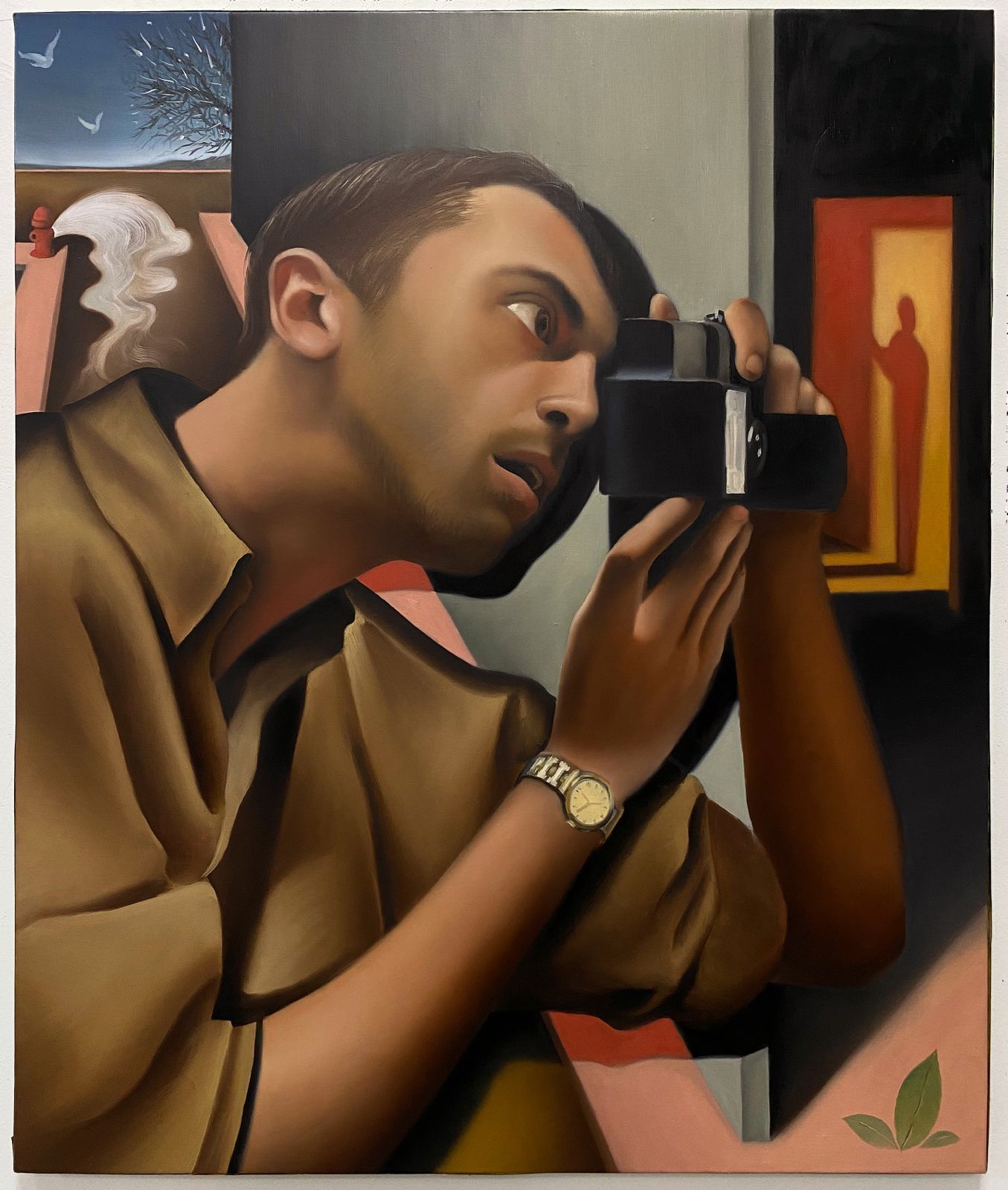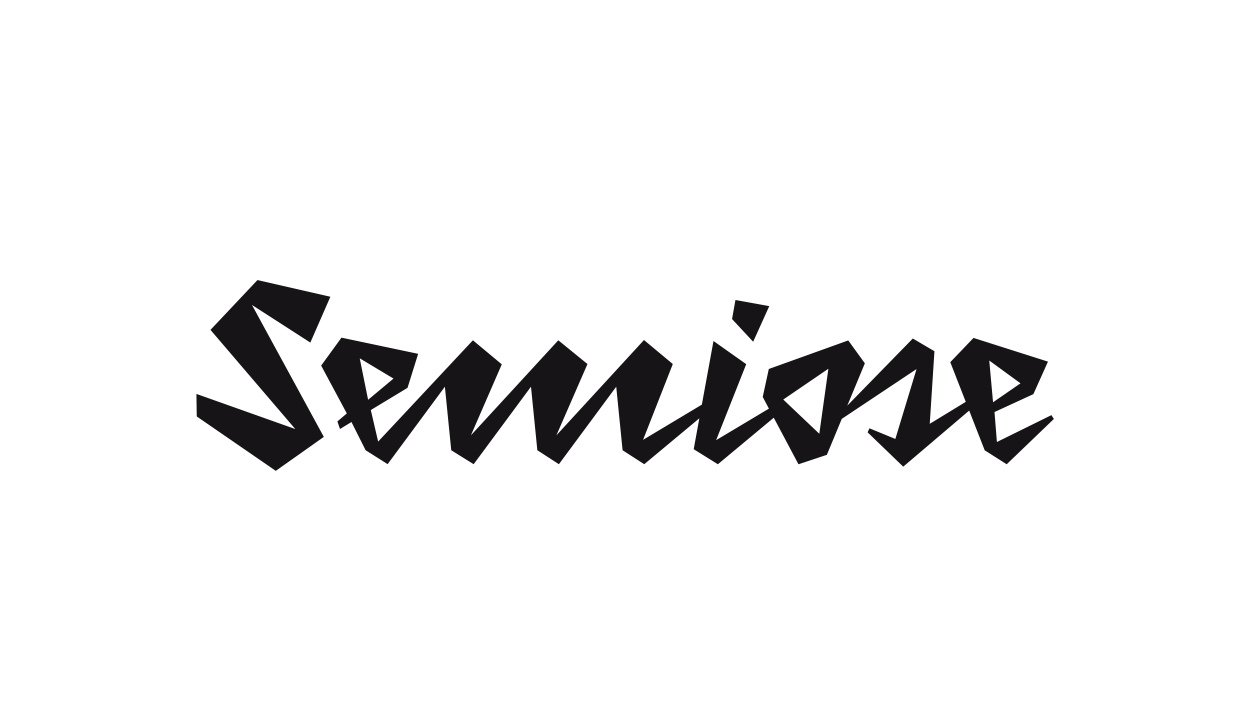All Sunsets Risen

C’est un double mouvement que raconte le titre de Justin Liam O’Brien, coucher (sunsets) / lever (risen), et comme pour toute force contradictoire arrive ce moment où elles se neutralisent, s’immobilisent. Arrêt… sur l’image. Rien à voir avec l’instantané photographique, plutôt la rencontre de deux cultures. D’abord celle des logiciels informatiques, de la 3D, des jeux vidéo, d’une formation en école d’animation, bref de l’image numérique et des écrans, surface de protection que Justin adolescent met entre lui et l’environnement réactionnaire et homophobe du comté de Suffolk à Long Island.
Ensuite, la peinture, qui arrive en 2017, et trouve sa confirmation après une visite déterminante au Louvre, qui a « littéralement changé (sa) vie, et certainement (sa) façon de peindre en 2019. »
2024. All Sunsets Risen expose l’état de grâce de ce double mouvement de libération : sortir des écrans comme sortir du placard, intégrer une culture queer dans des toiles qui disent le goût des hommes, inscrit dans une tradition classique. Il faudrait regarder les premiers tableaux de Justin O’Brien pour bien mesurer le chemin parcouru. Au départ des figures plutôt rondes, simplifiées, encore marquées par la modélisation 3D – « la façon dont j’aborde la lumière, l’ombre, la couleur, la forme est influencée de manière indélébile par les images numériques. » Et puis les personnages vont s’affiner. La peinture les déplie au fil des années, allonge le cou, les poignets, les mains dans des pauses qui se souviennent des hommes de Pontormo, Bronzino, Parmigianino. Pas une femme sur les toiles de cette série, mais une féminité maniériste revendiquée : « Les hommes sont mon sujet ; je ne pense pas en termes de genres, je suis plutôt adepte de cette croyance que tout tableau est un autoportrait. »
Qu’est-ce que j’entends dans cette déclaration ? Le mot « croyance » qui unit ces scènes de groupe, portraits d’hommes jeunes, les amis du peintre, sa communauté affective, tous liés par des signes de la main jusqu’au bout du bout des doigts, des mains qui ont l’expressivité rhétorique de la peinture religieuse. Deux index se touchent dans une scène de date au café, promesse profane d’une « création » amoureuse. Un poignet qui se casse, vu dans un rétroviseur, réfléchit celui des Christs déposés de Pontormo ou Bronzino, tandis qu’un avion déplie dans le ciel la devise biblique « There is only one way to heaven ». Ailleurs encore, gros plan sur deux paumes vers le ciel dans le geste dit de la « supination ».
Mais que raconte alors la peinture essentiellement narrative de Justin O’Brien ? À quoi, à qui croit-elle ? Peut-être à un monde d’hommes unis par l’idée de la rédemption amoureuse, une communauté queer de disciples dont il serait le « créateur ». Sa première exposition chez Semiose raconte l’état de grâce de ce monde originel, quand pour la première fois on devient amoureux. À la question : d’où vient son titre, Justin me répond : « J’ai écrit un poème le jour de la Saint-Valentin pour tenter de trouver une vision cohérente à cette série.
all sunsets risen
the heavens and earth merged
can you measure such a space?
as it expands or contracts
what about hope?
can you measure hope? »
Peut-on mesurer l’espoir ? Oui, si l’on croit.
The title of Justin Liam O’Brien’s exhibition evokes a dual movement in two opposing directions: sunsets / risen, and as always, when contradictory forces meet, there comes a moment when they neutralize each-other and come to a standstill. Freeze… on the image. Yet there’s nothing to do with photographic snaps in all of this, but rather the clash of two cultures. Firstly, that of computer software, 3D imaging, video games and a training course at an animation school—in short, the digital image and the screen, the protective barrier that a teenage Justin erected between himself and the conservative, homophobic environment of Suffolk County on Long Island.
Then in 2017, he began to paint, a change of direction confirmed by a visit to the Louvre in 2019, a watershed moment that “literally changed my life and certainly my way of painting.” Today in 2024, All Sunsets Risen showcases the state of grace of this dual movement of liberation: that of leaving the screen behind, as if coming out of the closet, integrating queer culture into canvasses that speak of masculine tastes, depicted in a classical tradition. In order to appreciate just how far he’s come, one needs to take a look at Justin Liam O’Brien’s early paintings. At first, his figures were more rounded and simplified, still influenced by 3D modelling: “the way I approach light, shadow, color and form is undeniably influenced by digital images.” As time went by, his figures became more refined, as if unfolding with each passing painting; necks, wrists and hands elongated in poses that remind us of the men portrayed by Pontormo, Bronzino and Parmigianino. There are no women in this series of paintings and the generally male figures are treated with an avowed mannerist femininity. “Men are my subject, without thinking in terms of gender, but rather in terms of this belief: every painting is a self-portrait.”
What does this statement entail? The word “belief” that connects these group scenes, portraits of young men, the painter’s friends, his intimate community, all linked by the depiction of hands, right down to their fingertips, hands that evoke the rhetorical expressiveness of religious paintings. Two index fingers touch, in a scene from a date in a café, a profane promise of a loving “creation.” A bent wrist, seen in a rear-view mirror, reflecting the Deposition of Christ by Pontormo or Bronzino, while a plane pulls a banner through the skies overhead, with the biblical message “There’s only one way to heaven.” Elsewhere, we see a close-up of two palms turned upwards towards the sky in a gesture known as supination.
So, what is Justin Liam O’Brien’s essentially narrative painting seeking to tell us? In what or in whom does he believe? Perhaps a world of men united by the idea of redemptive love, a queer community of disciples of whom he would be the “creator.” His first exhibition at Semiose bears witness to the “honeymoon period” of this highly original world, where people fall in love as if for the very first time. When asked where the title came from, Justin replied: “On Valentine’s Day, I wrote a poem in an attempt to find a coherent vision for this series of paintings:
All sunsets risen,
the heavens and earth merged.
Can you measure such a space?
As it expands and contracts
What about hope?
Can you measure hope?”
So, is it possible to measure hope? Yes, you just have to believe!
Laurent Goumarre

